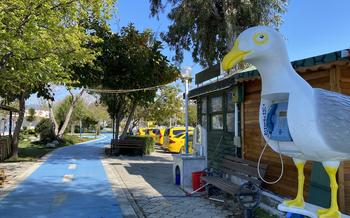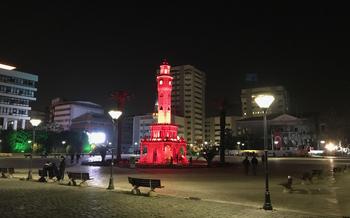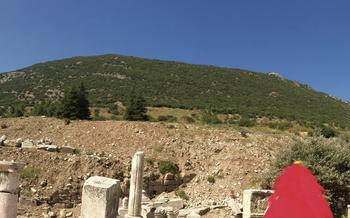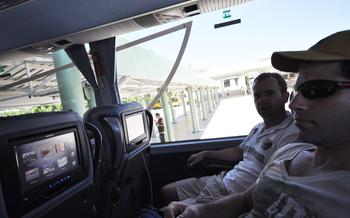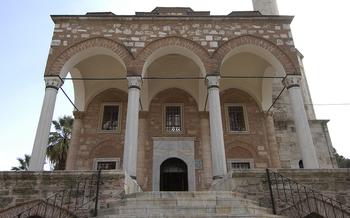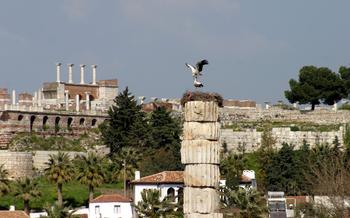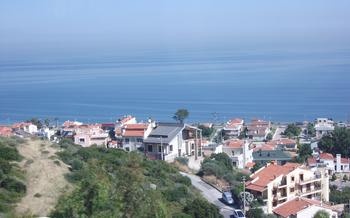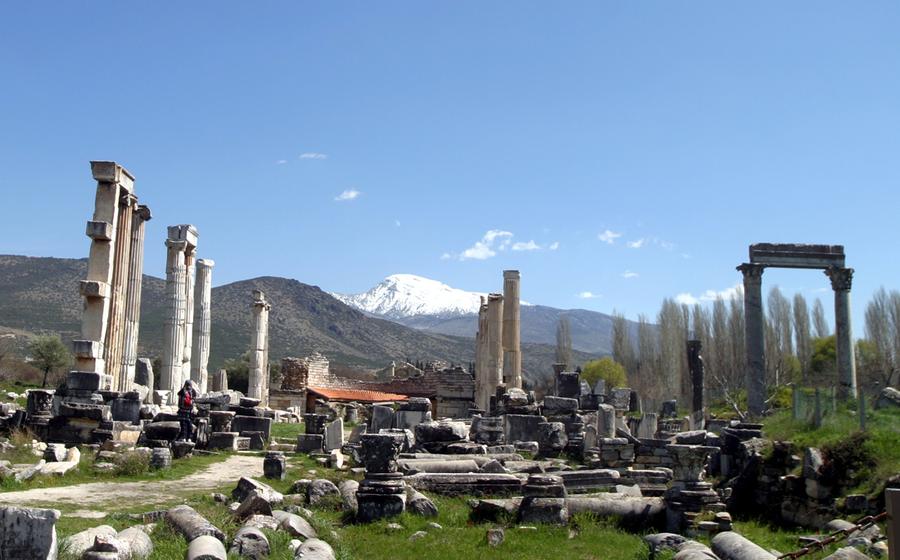
Aphrodisias Ancient City
- The Temple of Aphrodite: A Masterpiece of Ancient Architecture
- The Odeon: A Stage for Ancient Performances
- The Stadium: A Glimpse into Ancient Sports and Recreation
- The Agora: The Heart of Ancient Aphrodisias
- The Museum of Aphrodisias: A Treasure Trove of Ancient Artifacts
- The Necropolis: A Journey into the Afterlife
- The Aphrodisias Festival: A Celebration of Art and Culture
- Getting to Aphrodisias: A Journey to Ancient Lands
- Where to Stay: A Place to Rest and Reflect
- Food and Drink: A Taste of Local Flavors
- Shopping: Souvenirs and Treasures from Aphrodisias
- Safety and Security: A Worry-Free Journey
The Temple of Aphrodite: A Masterpiece of Ancient Architecture
The Temple of Aphrodite, the crowning jewel of Aphrodisias, stands as a testament to the city's devotion to its patron goddess and the remarkable architectural prowess of its ancient builders. Constructed in the 1st century BC, this awe-inspiring temple is a marvel of classical architecture, showcasing a harmonious blend of Greek and Roman influences.
Architectural Features: - The temple boasts a majestic facade adorned with intricate carvings and sculptures, depicting scenes from Greek mythology and the life of Aphrodite. - Its towering columns, each adorned with delicate fluting, support an elaborate entablature showcasing exquisite moldings and friezes. - The interior of the temple was once adorned with stunning marble statues and reliefs, many of which have been carefully preserved and are now displayed in the Aphrodisias Museum.
Significance in the Ancient World: - The Temple of Aphrodite was not merely a place of worship; it also served as a center for religious rituals, festivals, and celebrations honoring the goddess. - It was believed to be the birthplace of Aphrodite, and pilgrims from across the ancient world flocked to the temple to pay homage and seek her blessings.
Cultural and Religious Practices: - The temple was a focal point for religious ceremonies and rituals dedicated to Aphrodite. - Devotees would offer sacrifices, prayers, and votive offerings to the goddess, seeking her favor and protection. - The temple also hosted elaborate festivals and processions, where the statue of Aphrodite would be paraded through the streets of Aphrodisias.
Hidden Details and Symbols: - Look closely at the temple's friezes and sculptures to discover hidden symbols and iconography related to Aphrodite, such as doves, roses, and swans. - The temple's orientation is believed to have been carefully chosen to align with the rising sun on Aphrodite's birthday.
The Odeon: A Stage for Ancient Performances
Nestled amidst the ruins of Aphrodisias, the odeon stands as a testament to the city's vibrant cultural heritage. This ancient theater, designed with meticulous precision, boasts exceptional acoustics that transport visitors back in time to the era of captivating performances.
The odeon's intimate setting, with its gently sloping tiers of marble seats, creates an immersive atmosphere for audiences. Its stage, once graced by talented actors, musicians, and dancers, has witnessed countless spectacles that ignited the imaginations of ancient Aphrodisians.
Beyond its acoustics, the odeon's architectural design is a masterpiece in itself. Its intricate carvings and decorative elements, including stunning reliefs depicting mythological scenes, reflect the artistry and craftsmanship that characterized Aphrodisias.
For a truly immersive experience, consider attending a performance or event at the odeon. Local theater groups often stage plays, concerts, and traditional dance performances, allowing visitors to experience the magic of this ancient venue firsthand.
Whether you're a history buff, a theater enthusiast, or simply someone who appreciates architectural wonders, the odeon is a must-see attraction in Aphrodisias. Its enduring legacy as a stage for ancient performances continues to captivate visitors, offering a glimpse into the rich cultural traditions of this remarkable city.
The Stadium: A Glimpse into Ancient Sports and Recreation
The stadium in Aphrodisias is an impressive testimony to the ancient city's love of sports and entertainment. Built in the 1st century AD, it could accommodate up to 30,000 spectators, making it one of the largest stadiums in the Roman province of Asia.
The stadium was used for a variety of sports and games, including chariot races, wrestling, boxing, and track and field events. It also served as a venue for public spectacles, such as gladiatorial contests and animal hunts.
The stadium is well-preserved and its impressive size and grandeur are still evident today. Visitors can walk along the tiers of seats, which are divided into sections by staircases, and imagine the roar of the crowd as they cheered on their favorite athletes or marveled at the daring feats of the gladiators.
One of the most interesting features of the stadium is its elaborate system of underground tunnels and chambers. These tunnels were used by the gladiators and animals to enter the arena, and they also provided a means of escape in case of an emergency.
The Aphrodisias stadium is a fascinating glimpse into the world of ancient sports and entertainment. It is a must-see for anyone interested in history, archaeology, or sports.
The Agora: The Heart of Ancient Aphrodisias
The agora, situated at the heart of ancient Aphrodisias, served as a bustling marketplace and a vibrant gathering place for the city's inhabitants. As you step into this ancient square, imagine the lively atmosphere filled with merchants, shoppers, and citizens engaging in trade, social interactions, and political discussions.
The agora was a central hub for economic activities, where vendors displayed their wares in stalls and shops. From fresh produce and handcrafted goods to imported luxuries, the agora offered a diverse array of items for the city's residents to purchase. The air would have been filled with the sounds of bartering, the clinking of coins, and the laughter of people enjoying the lively atmosphere.
Beyond its commercial significance, the agora also played a crucial role in the political and social life of Aphrodisias. Citizens would gather here to discuss matters of governance, attend public assemblies, and celebrate civic events. The agora served as a platform for political debates, community decision-making, and fostering a sense of unity among the Aphrodisians.
As you explore the agora, take a moment to admire the well-preserved ruins that speak to its former grandeur. The colonnaded walkways provided shade and shelter to those seeking respite from the sun or rain, while fountains and statues adorned the square, adding to its aesthetic beauty. The agora stands as a testament to the vibrant community that once thrived within the walls of Aphrodisias.
When visiting the agora, be sure to explore the surrounding structures, including the bouleuterion, where the city council met, and the prytaneion, which served as the administrative center. These buildings offer further insights into the political and civic life of ancient Aphrodisias.
Whether you're a history buff, an architecture enthusiast, or simply curious about ancient cultures, the agora of Aphrodisias is a must-see destination. This vibrant marketplace and gathering place offers a glimpse into the heart of this once-thriving city, allowing you to connect with the past and imagine the bustling life that once filled its streets.
The Museum of Aphrodisias: A Treasure Trove of Ancient Artifacts
Among the many attractions of Aphrodisias, the Museum of Aphrodisias stands out as a must-visit destination for history and art enthusiasts. This remarkable museum houses a treasure trove of ancient artifacts that offer a glimpse into the rich cultural heritage of the city.
The museum's collection boasts an array of statues, sculptures, and artifacts that showcase the exceptional artistry and craftsmanship of the ancient Aphrodisians. Among the highlights are the famous Aphrodite of Aphrodisias, a stunning marble statue that captures the goddess's beauty and grace, and the headless statue of the city's founder, Gaius Julius Zoilos.
Other notable artifacts include intricate mosaics depicting scenes from mythology and daily life, finely carved reliefs, and a collection of coins that provide valuable insights into the economic and political history of Aphrodisias.
The Museum of Aphrodisias is not just a repository of ancient treasures; it's also a place of learning and discovery. Through its interactive exhibits and informative displays, the museum brings the ancient city to life, allowing visitors to understand the culture, beliefs, and way of life of the Aphrodisians.
To make the most of your visit, take your time to explore the museum's various galleries and exhibits. Each artifact has a story to tell, and the museum's knowledgeable staff is always ready to provide insights and answer questions.
Whether you're an art aficionado, a history buff, or simply someone with a thirst for knowledge, the Museum of Aphrodisias is a place that will leave you captivated and inspired.
The Necropolis: A Journey into the Afterlife
The ancient Aphrodisians believed in an afterlife, and their burial practices reflected this belief. The necropolis, or cemetery, of Aphrodisias is a vast and impressive sight, with tombs of various types and sizes scattered across the landscape. Some of the most notable tombs include the Temple Tomb, which features intricate carvings and a well-preserved statue of the deceased, and the Painted Tomb, which is adorned with colorful frescoes depicting scenes from Greek mythology.
Exploring the necropolis is a journey into the beliefs and customs of the ancient Aphrodisians. Visitors can gain insights into their views on death, the afterlife, and the importance of honoring the dead. It is a place of both beauty and solemnity, and it offers a glimpse into the lives and minds of a people who lived over two thousand years ago.
Here are some tips for exploring the necropolis respectfully:
- Dress modestly and behave respectfully, as this is a place of burial.
- Be aware of your surroundings and avoid disturbing any tombs or artifacts.
- Take your time and explore the necropolis at your own pace.
- If you have any questions, ask a local guide or museum staff for assistance.
The Aphrodisias Festival: A Celebration of Art and Culture
Held annually in the summer months, the Aphrodisias Festival is a vibrant celebration of the ancient city's rich heritage and cultural significance. Over several days, the festival fills the ancient ruins with music, dance, theater, and art exhibitions, bringing the city's history to life in a spectacular way.
The festival showcases the diverse talents of local and international artists, with performances ranging from classical concerts and traditional Turkish music to contemporary dance and theater productions. The ancient theater and odeon provide stunning backdrops for these performances, creating a truly immersive experience for visitors.
Beyond the performances, the festival also features exhibitions of ancient artifacts, workshops on traditional crafts, and lectures by renowned scholars and historians. These events offer visitors a deeper understanding of the ancient city and its enduring legacy.
The Aphrodisias Festival is a must-attend event for anyone interested in history, culture, and the arts. It's an opportunity to step back in time, experience the vibrant atmosphere of an ancient city, and celebrate the enduring power of human creativity.
Getting to Aphrodisias: A Journey to Ancient Lands
A journey to Aphrodisias is a journey to ancient lands, where history and culture intertwine. To reach this archaeological wonder, you have several options depending on your starting point.
Aphrodisias is conveniently located in the Aydın province of Turkey, approximately 130 kilometers from the coastal city of İzmir. If you're flying into Turkey, the nearest airport is İzmir Adnan Menderes Airport (ADB). From the airport, you can take a bus or rent a car to drive to Aphrodisias. The drive takes about 2 hours and 30 minutes, offering scenic views of the Turkish countryside.
If you prefer a more relaxed option, you can take a train from İzmir to Denizli, which takes about 3 hours. From Denizli, you can take a bus or taxi to Aphrodisias, which is about a 45-minute journey.
Once you arrive in Aphrodisias, you'll find yourself surrounded by ancient ruins and historical sites. Take your time to explore the city, soak in its rich history, and let the spirit of ancient Aphrodisias transport you back in time.
Where to Stay: A Place to Rest and Reflect
After a day of exploring the ancient ruins and immersing yourself in history, you'll need a comfortable place to rest and recharge. Aphrodisias offers a range of accommodation options to suit different budgets and preferences.
For a luxurious stay, consider the Aphrodisias Hotel, located just a short walk from the ancient city. This elegant hotel offers spacious rooms with stunning views of the surrounding countryside. Amenities include a swimming pool, a spa, and several restaurants serving delicious Turkish and international cuisine.
If you're looking for a more budget-friendly option, there are several guesthouses and hostels within easy reach of the ancient city. These offer basic but comfortable rooms, often with shared facilities. Some guesthouses also offer traditional Turkish breakfasts, allowing you to experience the local culture and cuisine.
For a truly unique experience, consider staying in a local homestay. This is a great way to connect with the local people and learn about their way of life. Homestays typically offer simple but comfortable rooms, as well as home-cooked meals prepared with fresh, local ingredients.
No matter your budget or preferences, you're sure to find a place to stay in Aphrodisias that meets your needs. Whether you choose a luxurious hotel, a cozy guesthouse, or a local homestay, you'll find a warm welcome and a comfortable place to rest and reflect on your journey through history.
Food and Drink: A Taste of Local Flavors
Aphrodisias and its surrounding region offer a delightful culinary experience, blending traditional Turkish flavors with local ingredients and recipes.
- Local Dishes and Specialties:
- Try the famous "Aphrodisias kebab," a succulent lamb dish cooked on skewers over an open fire.
- Savor the regional specialty, "incir tatlısı," a sweet pastry filled with dried figs, nuts, and spices.
-
Indulge in the fresh seafood caught from the nearby Aegean Sea, grilled to perfection.
-
Restaurants and Eateries:
- Visit local restaurants in the town of Aydın for authentic Turkish cuisine and warm hospitality.
- Explore the vibrant street food scene, where you can find delicious kebabs, gözleme (savory pancakes), and simit (sesame-encrusted bread).
-
Enjoy a leisurely meal at one of the many outdoor cafes, soaking in the charm of the ancient city.
-
Markets and Shops for Local Produce:
- Visit the bustling Aydın market, where you can find fresh fruits, vegetables, spices, and local delicacies.
- Stock up on Turkish delights, such as lokum (Turkish delight), baklava, and cezerye (carrot dessert).
-
Support local farmers and artisans by purchasing their homemade products, such as olive oil, honey, and traditional textiles.
-
Tips for Finding Authentic Turkish Cuisine:
- Venture off the beaten path and explore local eateries frequented by the locals.
- Ask your hotel or tour guide for recommendations on authentic Turkish restaurants.
- Don't be afraid to try new dishes and flavors; Turkish cuisine is known for its diversity and richness.
Shopping: Souvenirs and Treasures from Aphrodisias
A visit to Aphrodisias is not complete without taking home a piece of its rich history and culture. The city offers a variety of unique souvenirs and handicrafts that make for memorable keepsakes. From intricate pottery and handwoven textiles to replicas of ancient artifacts and jewelry, there's something for every taste and budget.
The local markets and shops are a treasure trove of authentic souvenirs. Haggling is not only acceptable but expected, so don't be afraid to bargain for a good price. You can find beautiful hand-painted ceramics, colorful kilims and carpets, and intricately carved wooden items that reflect the region's rich craftsmanship.
If you're looking for something truly special, consider purchasing a replica of an ancient artifact from Aphrodisias. These replicas are often made with great attention to detail and can be found in various shops and galleries throughout the city. From miniature statues of Aphrodite to replicas of ancient coins, these souvenirs offer a tangible connection to the city's past.
When shopping in Aphrodisias, it's important to support local artisans. Look for shops that sell handmade goods and avoid mass-produced items. This way, you can ensure that your purchases contribute to the local economy and help preserve the city's traditional crafts.
Here are some tips for finding quality souvenirs and supporting local artisans:
- Visit the local markets and bazaars, where you'll find a wide variety of handmade goods.
- Look for shops that display the "El Sanatları" sign, which indicates that the products are handmade.
- Ask shopkeepers about the origin of their products and support those who source their goods from local artisans.
- Be prepared to bargain, but do so respectfully and don't be afraid to walk away if the price is too high.
- Consider purchasing souvenirs that are made from local materials and reflect the region's unique culture.
Safety and Security: A Worry-Free Journey
Aphrodisias is generally a safe place to visit, but as with any travel destination, it's essential to take precautions to ensure your safety and security. Here are some tips to keep in mind:
-
Be aware of your surroundings: Pay attention to your surroundings and be mindful of people who may be acting suspiciously. Avoid walking alone at night, especially in isolated areas.
-
Protect your belongings: Keep your valuables safe by using a money belt or other security measures. Be careful with your bags and belongings, especially in crowded places.
-
Be respectful of local customs: Turkey is a Muslim country, so it's essential to be respectful of local customs and traditions. Dress modestly, especially when visiting religious sites.
-
Learn a few basic Turkish phrases: Learning a few basic Turkish phrases can help you communicate with locals and avoid misunderstandings.
-
In case of emergency: In case of an emergency, dial 112, the national emergency number in Turkey. You can also contact your embassy or consulate for assistance.

